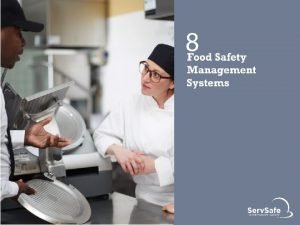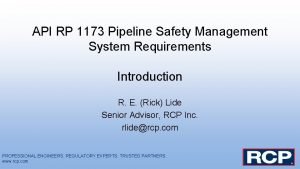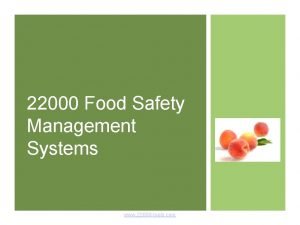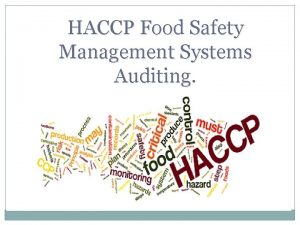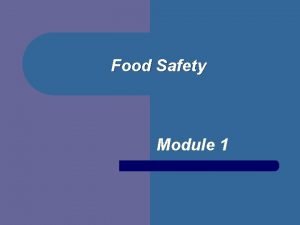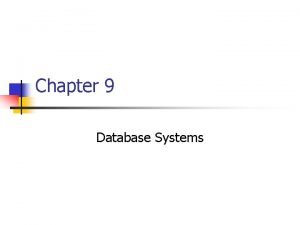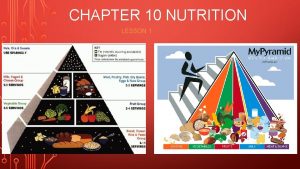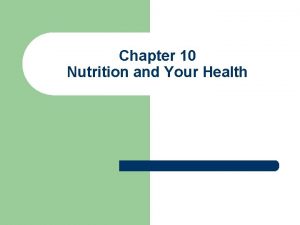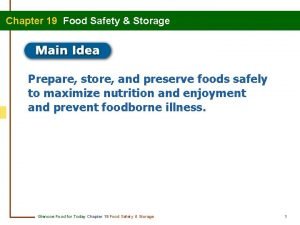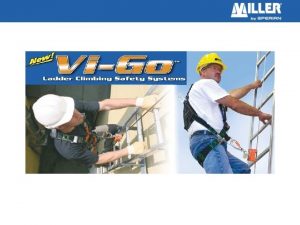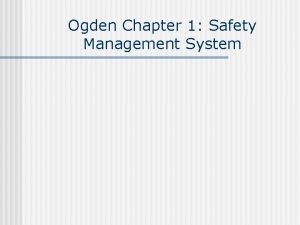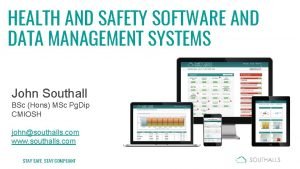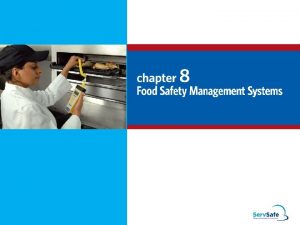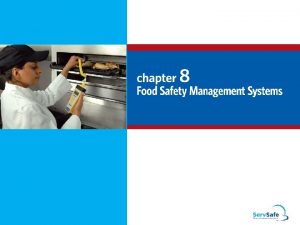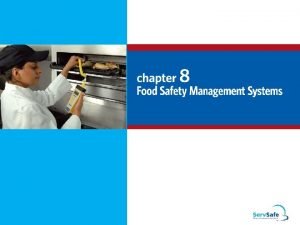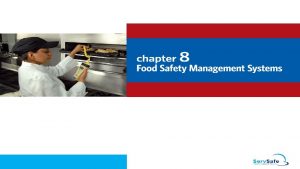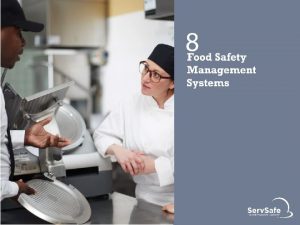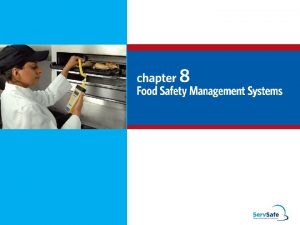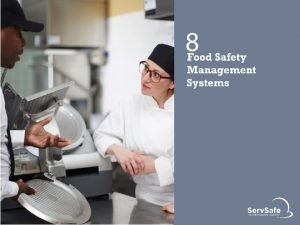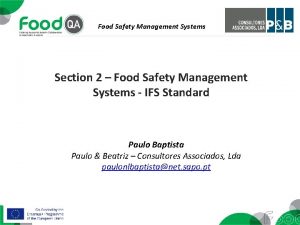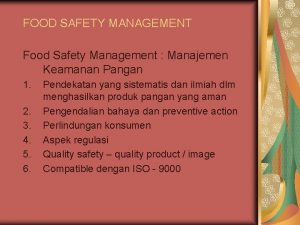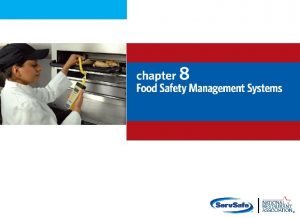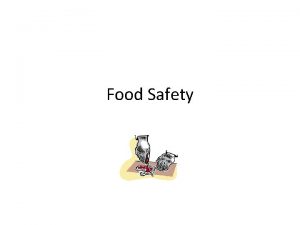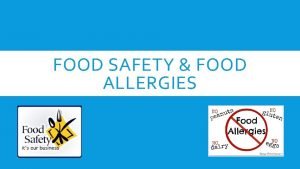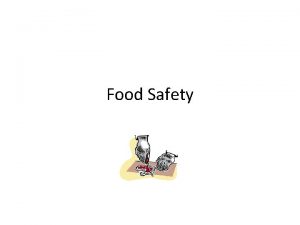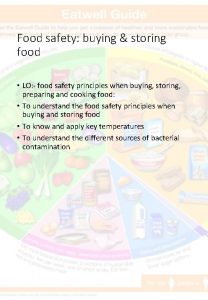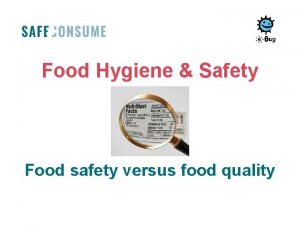Chapter 9 Food Safety Management Systems Food Safety
























- Slides: 24

Chapter 9 Food Safety Management Systems

Food Safety Management Systems Food Safety Management System 9 -2 l Group of procedures and practices intended to prevent foodborne illness l Actively controls risks and hazards throughout the flow of food l Active managerial control and Hazard Analysis Critical Control Point (HACCP) are 2 ways to build this system

Food Safety Programs These programs must first be in place: Personal hygiene program 9 -3 Facility design and equipment-maintenance program Supplier selection and specification program Food safety training program Sanitation and pest control programs

Active Managerial Control Focuses on controlling the CDC’s 5 most common risk factors that cause foodborne illness: 9 -4 1. Purchasing food from unsafe sources 2. Failing to cook food adequately 3. Holding food at incorrect temperatures 4. Using contaminated equipment 5. Practicing poor personal hygiene

Active Managerial Control: The Approach Steps for Using Active Managerial Control 1. Consider the 5 risk factors throughout the flow of food in your operation § Identify issues that could impact food safety 2. Create policies and procedures that address the issues you identified § § 9 -5 Consider asking staff for suggestions Provide training on these policies and procedures if necessary

Active Managerial Control: The Approach Steps for Using Active Managerial Control continued 3. Regularly monitor the policies and procedures that you developed 9 -6 § Can help determine if the policies and procedures are being followed § If not, you may have to revise them, create new ones, or retrain your staff

Active Managerial Control: The Approach Steps for Using Active Managerial Control continued 4. Verify that you are actually controlling risk factors § Use feedback from internal and external sources to adjust the policies and procedures for continuous improvement Internal sources: records, temperature logs, and selfinspections External sources: health-inspection reports, customer comments, and quality-assurance audits 9 -7

HACCP: The Approach The HACCP Approach 9 -8 l HACCP is based on identifying significant biological, chemical, or physical hazards at specific points within a product’s flow through an operation l Once identified, hazards can be prevented, eliminated, or reduced to safe levels

HACCP: The HACCP Plan To be effective, a HACCP system must be based on a written plan: 9 -9 l It must be specific to each operation’s menu, customers, equipment, processes, and operations l A plan that works for one operation may not work for another

HACCP: The 7 HACCP Principles 9 -10 1. Conduct a hazard analysis 2. Determine critical control points (CCPs) 3. Establish critical limits 4. Establish monitoring procedures 5. Identify corrective actions 6. Verify that the system works 7. Establish procedures for record keeping and documentation

HACCP: The 7 HACCP Principles Principle 1: Conduct a hazard analysis l Identify potential hazards in the food served by looking at how it is processed l Identify TCS food items and determine where hazards are likely to occur for each one; look for biological, chemical, and physical hazards Salads, cold sandwiches 9 -11 Prepare Grilled chicken sandwiches, hamburgers Prepare Chili, soup, sauces Cook Prepare Serve Cook Hold Serve Cool Reheat Serve

HACCP: The 7 HACCP Principles Principle 2: Determine critical control points (CCPs) 9 -12 l Find the points in the process where identified hazard(s) can be prevented, eliminated, or reduced to safe levels—these are the CCPs l Depending on the process, there may be more than one CCP

HACCP: The 7 HACCP Principles Principle 3: Establish critical limits 9 -13 l For each CCP, establish minimum or maximum limits l These limits must be met to: § Prevent or eliminate the hazard § Reduce it to a safe level Critical Limit

HACCP: The 7 HACCP Principles Principle 4: Establish monitoring procedures l Determine the best way to check critical limits § l 9 -14 Make sure they are consistently met Identify who will monitor them and how often

HACCP: The 7 HACCP Principles Principle 5: Identify corrective actions 9 -15 l Identify steps that must be taken when a critical limit is not met l Determine these steps in advance

HACCP: The 7 HACCP Principles Principle 6: Verify that the system works l Determine if the plan is working as intended l Evaluate on a regular basis: § § § l 9 -16 Monitoring charts Records Hazard analysis Determine if your plan prevents, reduces, or eliminates identified hazards

HACCP: The 7 HACCP Principles Principle 7: Establish procedures for record keeping and documentation Keep records for these actions: 9 -17 l Monitoring activities l Corrective actions l Validating equipment (checking for good working condition) l Working with suppliers (invoices, specifications, etc. )

HACCP: When a HACCP Plan Is Required A HACCP plan is required if an operation: 9 -18 l Smokes food as a method to preserve it (but not to enhance flavor) l Uses food additives or components such as vinegar to preserve or alter food so it no longer requires time and temperature control for safety l Cures food l Custom-processes animals

HACCP: When a HACCP Plan Is Required A HACCP plan is required if an operation: continued l Packages food using ROP methods including: § § § 9 -19 MAP Vacuum-packed Sous vide l Treats (e. g. , pasteurizes) juice on-site and packages it for later sale l Sprouts seeds or beans l Offers live, molluscan shellfish from a display tank

Crisis Management A crisis management plan should focus on 3 areas: 9 -20 l Preparation l Response l Recovery

Crisis Management: Preparation To prepare for a foodborneillness outbreak: 9 -21 l Create a crisis-management team l Train staff on food safety policies and procedures l Develop a foodborne-illness incident report form l Create an emergency-contact list l Develop a crisiscommunication plan

Crisis Management: Response When responding to a foodborne- Illness outbreak: 9 -22 l Take the complaint seriously and express concern l Complete an incident report form l Contact your crisismanagement team and the local health department l Follow your crisiscommunication plan

Crisis Management: Recovery To recover from a foodborne-Illness outbreak: 9 -23 l Work with the regulatory authority to resolve issues l Clean and sanitize all areas of the operation so the incident does not happen again l Throw out all suspected food l Investigate to find the cause of the outbreak l Establish new procedures or revise existing ones based on the investigation results l Develop a plan to reassure customers that the food served in your operation is safe

 Active managerial control software
Active managerial control software Api 1173
Api 1173 Control measures for physical hazards
Control measures for physical hazards Safety management system template
Safety management system template Fs22000 training
Fs22000 training Objectives of haccp
Objectives of haccp Food safety management arkansas
Food safety management arkansas Management information system chapter 1
Management information system chapter 1 Chapter 9 database management systems
Chapter 9 database management systems Introduction of mis
Introduction of mis Unit 2 food food food
Unit 2 food food food Grazing food chain diagram
Grazing food chain diagram Chapter 10 lesson 4 nutrition labels and food safety
Chapter 10 lesson 4 nutrition labels and food safety Chapter 10 lesson 4 nutrition labels and food safety
Chapter 10 lesson 4 nutrition labels and food safety Food safety and storage chapter 19
Food safety and storage chapter 19 Decision support systems and intelligent systems
Decision support systems and intelligent systems Principles of complex systems for systems engineering
Principles of complex systems for systems engineering Embedded systems vs cyber physical systems
Embedded systems vs cyber physical systems Engineering elegant systems: theory of systems engineering
Engineering elegant systems: theory of systems engineering Top management middle management first line management
Top management middle management first line management Management pyramid
Management pyramid Top level management
Top level management Vi go ladder climbing safety systems
Vi go ladder climbing safety systems Ogden safety systems
Ogden safety systems Southalls safety cloud
Southalls safety cloud
